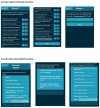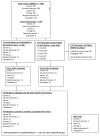Examining unanswered questions about the home environment and childhood obesity disparities using an incremental, mixed-methods, longitudinal study design: The Family Matters study
- PMID: 28800894
- PMCID: PMC5641262
- DOI: 10.1016/j.cct.2017.08.002
Examining unanswered questions about the home environment and childhood obesity disparities using an incremental, mixed-methods, longitudinal study design: The Family Matters study
Abstract
There are disparities in the prevalence of childhood obesity for children from low-income and minority households. Mixed-methods studies that examine home environments in an in-depth manner are needed to identify potential mechanisms driving childhood obesity disparities that have not been examined in prior research. The Family Matters study aims to identify risk and protective factors for childhood obesity in low-income and minority households through a two-phased incremental, mixed-methods, and longitudinal approach. Individual, dyadic (i.e., parent/child; siblings), and familial factors that are associated with, or moderate associations with childhood obesity will be examined. Phase I includes in-home observations of diverse families (n=150; 25 each of African American, American Indian, Hispanic/Latino, Hmong, Somali, and White families). In-home observations include: (1) an interactive observational family task; (2) ecological momentary assessment of parent stress, mood, and parenting practices; (3) child and parent accelerometry; (4) three 24-hour child dietary recalls; (5) home food inventory; (6) built environment audit; (7) anthropometry on all family members; (8) an online survey; and (9) a parent interview. Phase I data will be used for analyses and to inform development of a culturally appropriate survey for Phase II. The survey will be administered at two time points to diverse parents (n=1200) of children ages 5-9. The main aim of the current paper is to describe the Family Matters complex study design and protocol and to report Phase I feasibility data for participant recruitment and study completion. Results from this comprehensive study will inform the development of culturally-tailored interventions to reduce childhood obesity disparities.
Keywords: Childhood obesity disparities; Ecological momentary assessment; Home environment; Low-income; Minority; Mixed-methods.
Copyright © 2017 Elsevier Inc. All rights reserved.
Conflict of interest statement
Figures






Similar articles
-
Examining within- and across-day relationships between transient and chronic stress and parent food-related parenting practices in a racially/ethnically diverse and immigrant population : Stress types and food-related parenting practices.Int J Behav Nutr Phys Act. 2018 Jan 16;15(1):7. doi: 10.1186/s12966-017-0629-1. Int J Behav Nutr Phys Act. 2018. PMID: 29338753 Free PMC article.
-
Home Environmental Influences on Childhood Obesity in the Latino Population: A Decade Review of Literature.J Immigr Minor Health. 2017 Apr;19(2):430-447. doi: 10.1007/s10903-016-0539-3. J Immigr Minor Health. 2017. PMID: 28005241 Free PMC article. Review.
-
Utilizing a Board Game to Measure Family/Parenting Factors and Childhood Obesity Risk.J Nutr Educ Behav. 2019 Apr;51(4):419-431. doi: 10.1016/j.jneb.2018.12.008. Epub 2019 Feb 12. J Nutr Educ Behav. 2019. PMID: 30765297 Free PMC article.
-
Exploring How the Home Environment Influences Eating and Physical Activity Habits of Low-Income, Latino Children of Predominantly Immigrant Families: A Qualitative Study.Int J Environ Res Public Health. 2018 May 14;15(5):978. doi: 10.3390/ijerph15050978. Int J Environ Res Public Health. 2018. PMID: 29757941 Free PMC article.
-
Recruitment and retention in obesity prevention and treatment trials targeting minority or low-income children: a review of the clinical trials registration database.Trials. 2015 Dec 10;16:564. doi: 10.1186/s13063-015-1089-z. Trials. 2015. PMID: 26651822 Free PMC article. Review.
Cited by
-
Exploring the associations between neighbourhood food environment, household food insecurity and child weight-related outcomes in socio-economically and racially/ethnically diverse families.Public Health Nutr. 2022 Oct 10;25(12):1-10. doi: 10.1017/S1368980022002130. Online ahead of print. Public Health Nutr. 2022. PMID: 36210770 Free PMC article.
-
Associations between parental stress, parent feeding practices, and child eating behaviors within the context of food insecurity.Prev Med Rep. 2020 Jun 15;19:101146. doi: 10.1016/j.pmedr.2020.101146. eCollection 2020 Sep. Prev Med Rep. 2020. PMID: 32642403 Free PMC article.
-
Concordance of children's intake of selected food groups as reported by parents via 24-h dietary recall and ecological momentary assessment.Public Health Nutr. 2021 Jan;24(1):22-33. doi: 10.1017/S1368980020001111. Epub 2020 Jun 24. Public Health Nutr. 2021. PMID: 32576304 Free PMC article.
-
Spillover from parent stress to family meals among diverse families: An ecological momentary assessment study.J Fam Psychol. 2024 Jun;38(4):595-605. doi: 10.1037/fam0001204. Epub 2024 Feb 15. J Fam Psychol. 2024. PMID: 38358718 Free PMC article.
-
Intergenerational Pathways Between Parental Experiences of Adverse Childhood Experiences (ACEs) and Child Weight: Implications for Intervention.J Am Board Fam Med. 2023 Feb 8;36(1):39-50. doi: 10.3122/jabfm.2022.220134R1. Epub 2022 Dec 2. J Am Board Fam Med. 2023. PMID: 36460355 Free PMC article.
References
-
- Bethell C, Simpson L, Stumbo S, Carle AC, Gombojav N. National, State and Local Disparities in Childhood Obesity. Health Affairs. 2010;29(3):347–356. - PubMed
-
- NIH. Reducing health disparities among children: Strategies and programs for health plans. Washington DC: 2007.
-
- Ogden C, Lamb M, Carroll M, Flegal K. Obesity and Socioeconomic status in children and adolescents: United Stated, 2005–2008. NCHS Data Brief. 2010;(51) - PubMed
-
- Ogden C, Carroll M, Curtin L, Lamb M, Flegal K. Prevalence of high body mass index in US children and adolescents, 2007–2008. Journal of the American Medical Association. 2010;303(3):8. - PubMed
Publication types
MeSH terms
Grants and funding
LinkOut - more resources
Full Text Sources
Other Literature Sources
Medical

